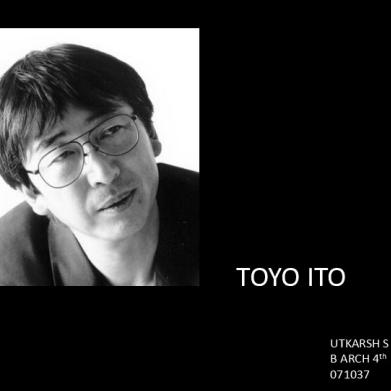Peter Eisenmann 1c5oa
This document was ed by and they confirmed that they have the permission to share it. If you are author or own the copyright of this book, please report to us by using this report form. Report 3b7i
Overview 3e4r5l
& View Peter Eisenmann as PDF for free.
More details w3441
- Words: 679
- Pages: 29
PETER EISENMAN
KSHITIZ AGARWAL B.Arch IV
ABOUT… • Peter Eisenman was born in Newark, New Jersey. • He studied at Cornell and Columbia Universities . • Eisenman first rose to prominence as a member of the New York Five. • In 2001, Eisenman won the National Design Award for Architecture from the CooperHewitt National Design Museum.
STYLE • Eisenman has always sought somewhat obscure parallels between his architectural works and philosophical or literary theory. • His earlier houses were "generated" from a transformation of forms related to the tenuous relationship of language to an underlying structure. • Eisenman's latter works show a sympathy with the ideas of deconstructionism.
• He tries to do is to ‘unlink’ the function that architecture may represent from the appearance - form - of that same architectural object. • Concepts: – Artificial excavation – Tracing – Layering – Deformation
• Techniques: • • •
• •
Shear Interference Intersection Distortion Scaling
• Artificial excavation • Find traces of history. • Interpret form and meaning. • Derive new forms and meaning by layering and deforming.
• Shear • Skew objects • Interference • Study interactions • Intersection • Emergent shapes • Distortion • Transform shapes • Scaling • Rotation
Method
• Historical reading of the site – Superposition
• Deformation strategy – Diagrammatic image
• Elaboration – Design
• Diagrammatic image – Additional elements – Outside architecture – Related to project – Informing and deforming
• Diagrammatic image – Add to superposition – Deform composition
Model
• Diagrammatic model • Physical scale model • Computer model
Deconstructionism • Characterized by ideas of fragmentation. • Characterized by a stimulating unpredictability and a controlled chaos. Coop Himmelblau (Wolf Prix), Vienna
IBA Block 2, Berlin
Works • House VI(Frank residence), Cornwall, Connecticut.Design: 1972. • Wexner Centre for the Arts, Ohio State University,Ohio, 1989 • Nunotani Building, Edogawa Tokyo Japan, 1991 • Greater Columbus Convention Centre, Ohio,1993 • Aronoff Centre for Design and Art, University for Cincinnati, Cincinnati, Ohio, 1996 • City of Culture of Galcia, Santiago de Compostela, Galcia, Spain, 1999 • Memorial to the Murdered Jews of Europe, Berlin, 2005 • University of Phoenix Stadium, Glendale , Arizona, 2006
House VI • Located in Cornawall,Connecticut. • Eisenman created a form from the intersection of four planes, subsequently manipulating the structures again and again, until coherent spaces began to emerge. • The envelope and structure of the building are just a manifestation of the changed elements of the original four slabs, with some limited modifications.
• The purely conceptual design meant that the architecture is strictly plastic, bearing no relationship to construction techniques or purely ornamental form.
column/beam intersection at red staircase
• The use of the red stairs in House VI is somewhat odd. • It is an upside down stairs, marked red, which functions only as to divide the building and provide the house with symmetry.
Wexner Center for the Arts • • • •
Location : Ohio State University,Ohio Building Type :University arts center. Construction System :steel, concrete, glass. Included in the Wexner Center space are a film and video theater, a performance space, a film and video post production studio, a bookstore, café, and 12,000 square feet (1,100 m²) of galleries.
• The design includes a large, white metal grid meant to suggest scaffolding, to give the building a sense of incompleteness. • The extension of the Columbus street grid generates a new pedestrian path into the campus, a ramped east-west axis. • a major part of the project is not a building itself, but a 'non-building'.
• Scaffolding traditionally is the most impermanent part of a building. • Thus, the primary symbolization of a visual arts center, which is traditionally that of a shelter of art, is not figured in this case. • For although this building shelters, it does not symbolize that function.
Conclusion • The architecture of Eisenman had many different angles and difficulties when analyzing it and trying to describe it in general .
“forms are no longer a ‘means toward an end,’ but an end in themselves”
Thank You…
KSHITIZ AGARWAL B.Arch IV
ABOUT… • Peter Eisenman was born in Newark, New Jersey. • He studied at Cornell and Columbia Universities . • Eisenman first rose to prominence as a member of the New York Five. • In 2001, Eisenman won the National Design Award for Architecture from the CooperHewitt National Design Museum.
STYLE • Eisenman has always sought somewhat obscure parallels between his architectural works and philosophical or literary theory. • His earlier houses were "generated" from a transformation of forms related to the tenuous relationship of language to an underlying structure. • Eisenman's latter works show a sympathy with the ideas of deconstructionism.
• He tries to do is to ‘unlink’ the function that architecture may represent from the appearance - form - of that same architectural object. • Concepts: – Artificial excavation – Tracing – Layering – Deformation
• Techniques: • • •
• •
Shear Interference Intersection Distortion Scaling
• Artificial excavation • Find traces of history. • Interpret form and meaning. • Derive new forms and meaning by layering and deforming.
• Shear • Skew objects • Interference • Study interactions • Intersection • Emergent shapes • Distortion • Transform shapes • Scaling • Rotation
Method
• Historical reading of the site – Superposition
• Deformation strategy – Diagrammatic image
• Elaboration – Design
• Diagrammatic image – Additional elements – Outside architecture – Related to project – Informing and deforming
• Diagrammatic image – Add to superposition – Deform composition
Model
• Diagrammatic model • Physical scale model • Computer model
Deconstructionism • Characterized by ideas of fragmentation. • Characterized by a stimulating unpredictability and a controlled chaos. Coop Himmelblau (Wolf Prix), Vienna
IBA Block 2, Berlin
Works • House VI(Frank residence), Cornwall, Connecticut.Design: 1972. • Wexner Centre for the Arts, Ohio State University,Ohio, 1989 • Nunotani Building, Edogawa Tokyo Japan, 1991 • Greater Columbus Convention Centre, Ohio,1993 • Aronoff Centre for Design and Art, University for Cincinnati, Cincinnati, Ohio, 1996 • City of Culture of Galcia, Santiago de Compostela, Galcia, Spain, 1999 • Memorial to the Murdered Jews of Europe, Berlin, 2005 • University of Phoenix Stadium, Glendale , Arizona, 2006
House VI • Located in Cornawall,Connecticut. • Eisenman created a form from the intersection of four planes, subsequently manipulating the structures again and again, until coherent spaces began to emerge. • The envelope and structure of the building are just a manifestation of the changed elements of the original four slabs, with some limited modifications.
• The purely conceptual design meant that the architecture is strictly plastic, bearing no relationship to construction techniques or purely ornamental form.
column/beam intersection at red staircase
• The use of the red stairs in House VI is somewhat odd. • It is an upside down stairs, marked red, which functions only as to divide the building and provide the house with symmetry.
Wexner Center for the Arts • • • •
Location : Ohio State University,Ohio Building Type :University arts center. Construction System :steel, concrete, glass. Included in the Wexner Center space are a film and video theater, a performance space, a film and video post production studio, a bookstore, café, and 12,000 square feet (1,100 m²) of galleries.
• The design includes a large, white metal grid meant to suggest scaffolding, to give the building a sense of incompleteness. • The extension of the Columbus street grid generates a new pedestrian path into the campus, a ramped east-west axis. • a major part of the project is not a building itself, but a 'non-building'.
• Scaffolding traditionally is the most impermanent part of a building. • Thus, the primary symbolization of a visual arts center, which is traditionally that of a shelter of art, is not figured in this case. • For although this building shelters, it does not symbolize that function.
Conclusion • The architecture of Eisenman had many different angles and difficulties when analyzing it and trying to describe it in general .
“forms are no longer a ‘means toward an end,’ but an end in themselves”
Thank You…










